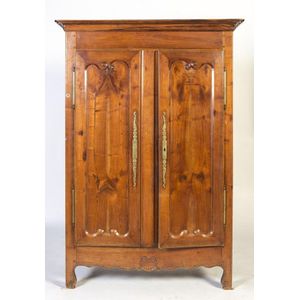Louis XV Style Painted Armoire with Craquelure Finish
You must be a subscriber, and be logged in to view price and dealer details.
Subscribe Now to view actual auction price for this item
When you subscribe, you have the option of setting the currency in which to display prices to $Au, $US, $NZ or Stg.
- Cornice - The upper section of a high piece of furniture such as a bookcase, wardrobe or cabinet that sits immediately on the main structure. The cornice is usually decorated with a variety of architectural mouldings, worked either with a moulding plane or, from the later 19th century, by machine. The front and side of the cornice are mitred together, strengthened by glue blocks, and the back is generally a simple dovetailed rail to hold the structure together. Cornices are generally, though not always, fitted separately to the piece and are held in place either by screws sunk into the top board or by wooden corner blocks. A pediment may sit above the cornice, but sometimes the terms cornice and pediment are used interchangeably.
- Frieze - An architectural term denoting the flat, shaped or convex horizontal surface of furniture, between the architrave and the cornice, usually found on a cabinet or bookcase, or on desks and tables where it may include drawers, the area between the top and the legs. In ceramics, the term refers to the banding, of usually a repeating pattern, on the rims of plates and vases.
- Limed / Cerused Finish - A process for finishing timber whereby the surface was covered with a coating of lime, which was subsequently brushed from the surface, but allowed to remain in the grain. The resulting surface with its streaking and speckling of white was usually left unpolished. The finish was popular for French furniture in the late 19th century, and English cottage style furniture in the early 20th century. Oak timber was popular for liming because its open grain retained a larger amount of the lime than other close grained timbers.
Nowadays the same effect can be achieved by use of paint, or proprietry solutions for "liming". - Apron - A decorative wooden panel that sits underneath the top surface of a table or chair, and unites the top of the piece with the legs, running at right angles to the underside. On carcase furniture such as a chest or wardrobe, the apron sits below the drawers or doors and attaches to the legs.
On carcase furniture without legs the panel under the drawers or doors sits on the floor and is termed a plinth.
An apron can provide a decorative touch to an otherwise unadorned piece of furniture and at the same time provide structural support and strength. They can be carved or pierced and quite elaborate.
This item has been included into following indexes:
- armoires 300
Visually similar items

A Georgian period oak country corner cabinet, the panelled cupboard door with star inlay and cross-banded border, brass H-hinges and dentil mouldings beneath the top edge. The interior with three serpentine shelves. 68 cm x 38 cm x 100 cm

A Louis XV period carved oak armoire, circa 1770 the moulded cornice with foliate carved decoration above a frieze of scrolling acanthus leaves above two long doors with raised panels enclosing shelves, raised on short cabriole legs, 162 cm wide, 66 cm dee

A French provincial Cherrywood armoire with later cornice, 18th /19th century, 204 cm high, 142 cm wide, 68 cm deep

A French provincial cherry wood sideboard, 18th century, 102 cm high, 126 cm wide, 54 cm deep
